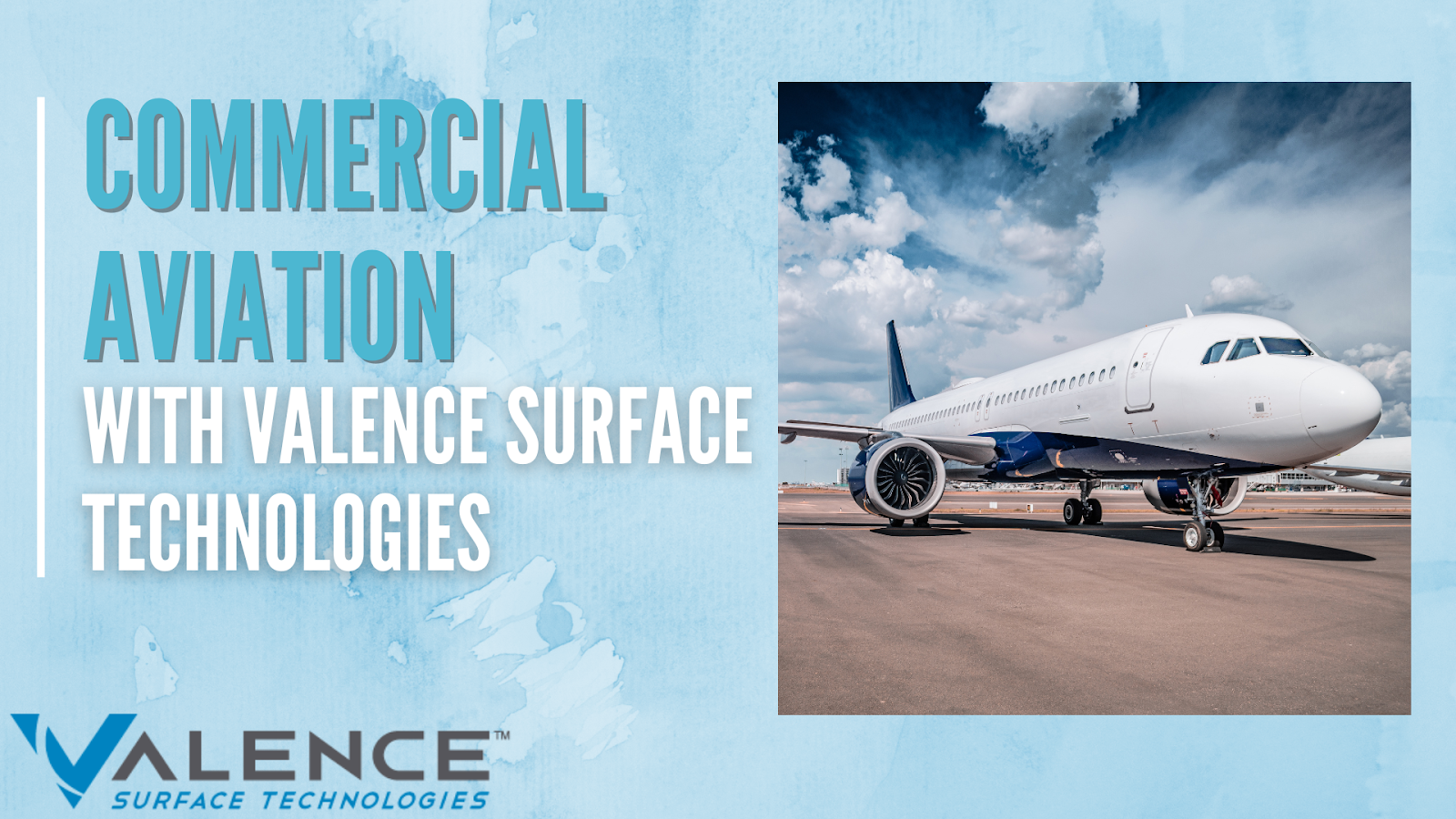Commercial Aviation
OEMs, Programs
Airbus
Boeing
787
Bombardier
CRJ Series
Embraer
E170/175
E190/195

As a sector driven by technological precision and unwavering commitment to safety, every aspect of an aircraft’s performance counts. At Valence Surface Technologies, we understand the profound impact of surface treatments and coatings on aviation’s operational efficiency, longevity, and environmental responsibility. Our mission is clear: to bolster the commercial aviation industry with exceptional surface finishing solutions that meet and exceed the exacting demands of original equipment manufacturer (OEM) programs.
What Is Commercial Aviation?
Commercial aviation refers to the industry and activity involving the operation of aircraft for the purpose of transporting passengers and cargo for profit. It encompasses a wide range of services, from scheduled passenger flights on large airliners to cargo transportation, charter services, and regional or smaller aircraft operations.
Elevate Your Aerospace Finishing Experience With Valence!Discover the Valence Advantage:
Ready to soar above the rest? Contact us today to unlock the Valence difference! |

Importance Of Commercial Aviation
Commercial aviation serves as a crucial vehicle for global connectivity, enabling individuals to travel for both personal and business purposes, fostering international trade, and promoting cultural exchange. It acts as a potent catalyst for economic growth, generating jobs, bolstering tourism, and propelling development in related sectors such as hospitality, manufacturing, and transportation.1
With its unparalleled speed, commercial aviation efficiently reduces travel time, enhancing productivity and efficiency in various spheres of life. Additionally, it assumes a critical role in delivering emergency medical aid, responding to disasters, and supporting humanitarian efforts, making it an indispensable asset for swift crisis response and relief during times of need
How Does Commercial Aviation Work?
Commercial aviation involves a complex system of processes and stakeholders working together. Here’s how it typically works:
- Airlines: Airlines operate scheduled flights, managing a fleet of aircraft to transport passengers and cargo. They handle ticketing, reservations, ground operations, and customer service.
- Airports: Airports serve as the infrastructure for commercial aviation. They provide runways, terminals, and facilities for aircraft to take off, land, and park. Airports also handle security screenings, baggage handling, and air traffic control.
- Aircraft: Commercial aircraft are designed and manufactured by OEMs (Original Equipment Manufacturers). These aircraft undergo stringent certification processes to ensure they meet safety standards. Airlines then purchase or lease these aircraft for their operations.
- Support Services: Several support services are essential for commercial aviation, including air traffic control, maintenance and repair organizations, catering, fueling, and ground handling. These services ensure the smooth operation of flights and passenger comfort.
Benefits Of Commercial Aviation
Commercial aviation offers a myriad of advantages, rendering it an indispensable facet of modern global transportation. Its significance is multifaceted and deeply entrenched in various aspects of our lives:
Speed And Efficiency
Commercial aviation is synonymous with rapid travel, especially for long distances. It saves precious time, making it the preferred choice for business professionals and individuals with time-sensitive commitments. The ability to reach destinations quickly is a hallmark of commercial aviation.
Global Connectivity
The aviation industry is the ultimate connector, seamlessly joining people and businesses worldwide. It acts as a catalyst for international trade, tourism, and cultural exchange. This connectivity drives economic growth, fosters innovation, and fuels societal development, essentially breaking down geographical barriers.
Accessibility
Commercial aviation brings previously inaccessible or remote locations within easy reach. It enables travelers to explore diverse geographic regions, spurring tourism in both well-established and emerging destinations.
Cargo Transportation
Beyond passenger travel, commercial aviation plays a pivotal role in the global logistics chain. It provides a rapid and efficient means of transporting goods and merchandise across the world.
Significant Elements Of Commercial Aviation OEMs Programs
Commercial aviation original equipment manufacturers (OEMs) play a crucial role in the aerospace industry. In order to understand the scope and impact of commercial aviation OEMs programs, it is important to delve into their significant elements. Here are the key aspects that make these programs stand out:
- Technological Innovations: Commercial aviation OEMs continuously invest in research and development to incorporate advanced technologies in their programs. These innovations not only improve the performance and safety of aircraft but also enhance fuel efficiency, reduce emissions, and offer a superior passenger experience.
- Design And Engineering: The design and engineering phase of commercial aviation OEMs programs focuses on creating sleek and aerodynamically efficient aircraft. These programs involve advanced modeling and simulation techniques to optimize aircraft structures, systems, and components.
- Supply Chain Management: Ensuring a smooth supply chain is vital for commercial aviation OEMs programs. Collaboration with suppliers, efficient logistics, and quality control play a crucial role in meeting production schedules, maintaining product quality, and reducing costs.
- Manufacturing Excellence: Commercial aviation OEMs programs emphasize manufacturing excellence to meet the rigorous standards of the aerospace industry. Implementing lean manufacturing practices, advanced automation, and stringent quality control measures ensure that each aircraft is built to the highest specifications.
- Certification And Compliance: Compliance with regulatory and safety standards is paramount in commercial aviation OEMs programs. Obtaining certifications from authorities such as the Federal Aviation Administration (FAA) and adhering to industry-specific regulations are integral parts of the manufacturing process.
Scope And Impact Of Commercial Aviation OEMs
Commercial aviation OEMs have a profound impact on the aerospace industry. Their programs encompass a wide range of activities that extend beyond the manufacturing process. Here is a closer look at the scope and impact of commercial aviation OEMs:
Economic Contribution
The commercial aviation OEMs sector significantly contributes to the global economy. The programs generate jobs, drive innovation, and create a ripple effect that positively impacts related industries, such as aerospace engineering, logistics, and maintenance, repair, and overhaul (MRO) services.
Technology Transfer
As commercial aviation OEMs develop cutting-edge technologies for aircraft manufacturing, their programs facilitate technology transfer to other industries. This cross-pollination of ideas and innovations benefits various sectors, including defense, space, and satellite industries.
Environmental Responsibility
Commercial aviation OEMs programs address the industry’s growing concern for sustainable aviation. By investing in research and development, OEMs aim to develop eco-friendly aircraft designs, lightweight materials, and fuel-efficient engines, minimizing the environmental impact of flying.
To be at the forefront of this dynamic aerospace industry, we encourage you to partner with Valence Surface Technologies for exceptional aerospace product finishing. Join us in shaping the future of aerospace today.
Unveiling Commercial Aviation OEMs
To gain a comprehensive understanding of commercial aviation OEMs programs, it is important to unveil their intricacies. Here, we delve deeper into the multifaceted aspects of these programs:
- Collaborative Approach: Commercial aviation OEMs programs require collaboration with various stakeholders, including suppliers, airlines, and regulatory bodies. Emphasizing open communication and fostering strong partnerships enable OEMs to develop innovative solutions and deliver aircraft tailored to meet specific requirements.
- Customization And Variants: Commercial aviation OEMs programs offer customization options and variants to cater to the diverse needs of airlines. From cabin layouts to range capabilities, these programs provide flexibility to adapt aircraft designs according to specific market demands.
- Aftermarket Services: Beyond aircraft manufacturing, commercial aviation OEMs programs encompass an extensive range of aftermarket services. These include spare part distribution, maintenance, repairs, and upgrades. Building a strong aftermarket support network is crucial to ensure airlines can effectively operate and maintain their fleets.
- Global Reach: Commercial aviation OEMs programs have a global reach, with a network of manufacturing facilities, suppliers, and customers spanning across continents. This global presence enables OEMs to cater to the demands of the international aviation market and contribute to the economic growth of various regions.
The Future Of Commercial Aviation OEMs
The future of commercial aviation OEMs promises unprecedented technological strides and transformative innovations. Advancements in materials science, propulsion systems, and avionics are reshaping the industry landscape.
OEMs are actively engaged in research and development, focusing on sustainable aviation solutions, from electric and hybrid propulsion to lightweight composite structures, revolutionizing aircraft designs for enhanced fuel efficiency and reduced environmental impact.
Additionally, digitalization and artificial intelligence are becoming integral, optimizing aircraft performance, predictive maintenance, and passenger experience. Collaborations between OEMs and emerging aerospace startups further accelerate innovation, ensuring a future where commercial aviation is not only more efficient and environmentally responsible but also pushes the boundaries of what air travel can achieve.
Final Thoughts On Commercial Aviation
Commercial aviation stands as an intricate and ever-evolving ecosystem that deeply influences global connectivity, commerce, and technological innovation. Its ability to swiftly traverse vast distances, facilitating not only business but also cultural exchange and personal journeys, is remarkable. Moreover, it serves as an economic powerhouse, fostering job creation and encouraging advancements in multiple sectors. While environmental concerns pose challenges, the industry is actively seeking sustainable solutions, promising a more eco-friendly future.
As the world’s largest independent aerospace product finishing company, Valence Surface Technologies understands the significance of surface finishing in the aviation, defense, and space industries. With our unparalleled expertise and unwavering commitment to excellence, we provide a seamlessly integrated solution tailored to the distinctive requirements of these industries. Contact us today to see how we can help you achieve superior surface finishing and more in the world of commercial aviation.
Read Also:
- Chrome Coating: A Necessary Investment for Aerospace Components
- Gold Plating: The Best Way To Protect Aerospace Components From Tarnish
- An Overview Of Titanium Anodizing And Its Applications In Aerospace
Frequently Asked Questions About Commercial Aviation
What are the requirements to become a commercial pilot?
To become a commercial pilot, you’ll need to meet specific requirements, including obtaining a Private Pilot License (PPL), acquiring a Commercial Pilot License (CPL), accumulating flight hours, completing training and examinations on aircraft systems, meeting medical and physical fitness criteria, and obtaining additional certifications like Instrument Rating and Multi-Engine Rating.
What is the primary revenue source for commercial aviation?
The primary source of revenue is passenger travel. Airlines generate revenue through ticket sales, offering various classes, seat types, and fare structures. They also make money from additional services like cargo transportation, onboard sales, and partnerships.
How does air traffic control work in commercial aviation?
In commercial aviation, air traffic control (ATC) ensures safe and orderly air traffic flow. ATC controllers monitor aircraft through radar and communication, providing guidance on routes, altitude, and separation between aircraft. They coordinate takeoffs, landings, and en-route aircraft movements, maintaining efficient and safe operations in controlled airspace.
How are flight scheduling and routing done in commercial aviation?
Flight scheduling and routing in commercial aviation involve meticulous planning. Airlines consider factors like passenger demand, aircraft availability, airport congestion, and fuel efficiency. Using computerized systems and algorithms, they create flight schedules and plan routes based on air traffic regulations, weather conditions, and optimal flight paths.
What is the impact of fuel costs on commercial aviation?
Fuel costs have a significant impact on commercial aviation as they constitute a substantial portion of airlines’ operating expenses. Fluctuations in fuel prices can directly affect ticket prices, profitability, and operational decisions. Airlines often employ fuel-efficient technologies and strategies to mitigate these costs and maintain competitive pricing while reducing their environmental footprint.
What is the role of ground staff in commercial aviation?
Ground staff in commercial aviation play crucial roles, including assisting passengers with check-in, baggage handling, and boarding, managing passenger services, coordinating ramp operations, providing gate services, and ensuring compliance with safety and security regulations at airports.
How does weather affect commercial aviation?
Severe weather can lead to delays, cancellations, or diversions. Airlines and pilots rely on weather forecasts and reports to make informed decisions regarding flight plans, takeoff and landing, and route changes for passenger and crew safety.
How is commercial aviation regulated?
Commercial aviation is heavily regulated to ensure safety and operational standards. Government agencies, like the Federal Aviation Administration (FAA), establish and enforce rules for aircraft design, maintenance, pilot training, air traffic control, and safety management systems. Regular inspections and certifications ensure compliance.
How does commercial aviation impact the environment?
Commercial aviation has environmental impacts, primarily through emissions and noise pollution. Emissions from aircraft engines, such as carbon dioxide (CO2), contribute to climate change. The industry focuses on technological advancements, alternative fuels, and operational efficiencies to reduce emissions and promote sustainability.
What security measures are in place in commercial aviation?
Security measures in commercial aviation are stringent, including passenger and baggage screening, airport access controls, enhanced international travel security, air marshals on some flights, and collaboration among airlines, intelligence agencies, and law enforcement to identify and address potential threats.
Sources:
- Uniting Aviation. (2018, February 28). Aviation Benefits: contributing to global economic prosperity. Uniting Aviation. https://unitingaviation.com/news/economic-development/aviation-benefits-for-a-better-future/



